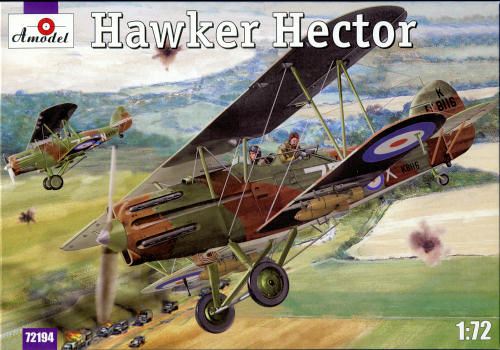The Hector was intended as a replacement for the Hawker Audax army co-operation aircraft. The design and the building of the prototype was done by Hawkers but production aircraft were built by Westland Aircraft in Yeovil, Somerset. Because of the demand for Rolls-Royce Kestrel engines required for the Hawker Hind programme, an alternative power plant was specified. Consequently, the Napier Dagger III was used. The prototype first flew on 14 February 1936 with George Bulman as pilot. One prototype and 178 production aircraft were built. 13 of these were supplied to Ireland in 1941–2.

-----------------------------
Hector Mk I are two-seat army co-operation aircraft for the RAF.
---------
General characteristics
Crew: Two
Length: 9.09 m
Wingspan: 11.26 m
Height: 3.18 m
Wing area: 33.1 m²
Empty weight: 1,537 kg
Loaded weight: 2,227 kg
Powerplant: 1 × Napier Dagger III 24-cylinder air-cooled H-block engine, 805 hp (601 kW)
Maximum speed: 301 km/h at 1,999 m
Stall speed: 80.5 km/h
Range: 483 km
Service ceiling: 7,815 m
Wing loading: 67.3 kg/m²
Power/mass: 0.27 kW/kg
Climb to 3,000 m, 5 min 40 s
Armament: 1 × forward-firing 7.7 mm Vickers machine gun Mk.V
+ 1 × 7.7 mm Lewis gun in the rear cockpit on a Hawker mount
Bombs: Mountings for a camera, flares, and 2 × 50 kg bombs or containers
---------------------------
Starting in February 1937, the Hector equipped seven RAF army co-operation squadrons, but began to be replaced by Westland Lysanders from July 1938. The Hectors were transferred to Auxiliary Air Force squadrons; 613 Squadron were in the course of converting to Lysanders at RAF Hawkinge when they flew in support of the Allied garrison in the Siege of Calais. On 26 May, along with the squadron's Lysanders, six Hectors dive bombed German positions around Calais and on the following day, attempted to drop supplies to the troops, unaware that they had already surrendered; two Hectors were lost. Hectors were used by the RAF from 1940 as target-tugs, and for towing the General Aircraft Hotspur training glider.
(wings palette picture)
Irish Air Corps examples were received after the Dunkirk Evacuation. In general they were in poor condition. They were sold by the British War Office to Ireland upon requests for aircraft. The Irish military were wholly unprepared for major warfare, but still relied almost totally on military supplies from Britain. The defence of Ireland was also in the British interest, but with the Battle of Britain raging in the skies, could afford to sell the Irish Government nothing better than the Hector. The type was deeply unpopular with ground crews due to the complicated nature of the Dagger engine, which had 24 cylinders, with 24 spark plugs and 48 valves, all of which required frequent maintenance.
Ei kommentteja:
Lähetä kommentti
Kaikenlaiset kommentit ovat tervetulleita.